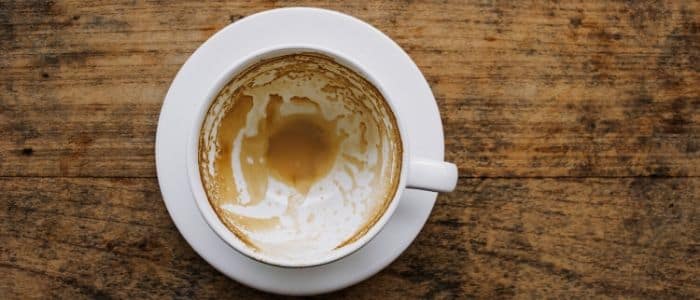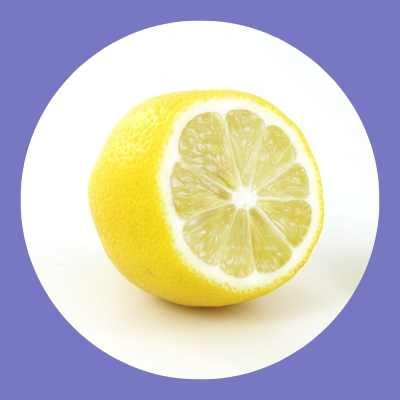As I was unloading my dishwasher this morning, I noticed that my mugs were pretty badly tea stained. This is probably due to my annual winter daily tea-drinking habit. I love the comfort of hot tea on cold days, but I don’t love what it does to my cups and mugs. We drink a ton of coffee and tea in this house, so stained cups are inevitable. Luckily for me, an old hack I learned from my years of waiting tables in restaurants makes my cups sparkly clean again. This method I first learned to use on glass coffee carafes to clean the burnt-on coffee stains, but I found that it works so well for those tough tea stains too. Guys, this is so easy and quick. You have to give it a try!

What Causes Coffee and Tea Stains Anyway?
Tannins. Tannins are the polyphenol compounds in plants that are found in tea, coffee, wine, and chocolate, to name a few. Tannins are responsible for giving food and beverage a bitter and dry mouthfeel. When I was on a sensory panel, we called the astringent, drying mouthfeel of our drink products “tannin” because it represented the mouthfeel that you get when you drink tea or coffee. The tannins also dye and stain things like cups, mugs, teeth, carpet, clothes, furniture…you get it, they stain. Add that staining power to heat from a hot beverage and then further bake it on during the dishwashing cycle, and you have quite the stained cup!
I’m a science nerd and could geek out and tell you all about tannins and plants and such, but we are here for cleaning tea stains, right? Tannins aren’t all bad news and actually have a number of health benefits that I am not qualified to tell you about. If you want to know more about the science-y stuff, this Healthline article on tea tannins is a fantastic source of information.
How to Remove Tea and Coffee Stains From Cups and Mugs
This first method is the one I’ve used for years with great success, and it is so fast and easy to do. The basic idea is to use a mild abrasive product and an acid to break down the tea stains. I will leave a list of the most natural acids and mild abrasives as well, so you can mix and match based on what you might have on hand.
My Ol’ Faithful Lemon Juice and Salt Scrub
You’ll need:
Add a couple of tablespoons of salt to a small bowl. Then add lemon juice to make a paste. Use your cloth and scoop up a bit of the mixture onto the cloth and begin to scrub in circular motions to remove the stains, and voila! You could also put the salt directly on a fresh slice of lemon and scrub that way. I just prefer using a cloth since it’s easier to handle.
For a glass coffee pot or carafe, add about a tablespoon of salt, lemon juice or slices of fresh lemon (I eyeball the amount since you don’t really have to be precise), and some ice cubes. Swirl the mixture in the coffee pot for a minute or so. If there are still visible stains, use a cloth to wipe them out. Rinse the coffee pot and enjoy!

Mild Abrasives
Baking soda – you can use baking soda on its own to tackle tea stains or in combination with lemon juice or vinegar. You can soak your mug in water and baking soda, make a paste of water and baking soda and let it sit and then scrub it off.
Salt – is inexpensive and makes a great scrubbing agent, especially in combination with an acid. However, in a pinch, you could probably use it on its own with the addition of a little elbow grease.
Sugar – is another mild abrasive that everyone usually has on hand. Much like salt, it can be used on its own or with an acid to remove tea stains.
Acids
Lemon juice – is a great natural option and smells divine to boot! I love to use it with salt, but I’m sure it would play well with sugar and baking soda as well.
White vinegar – what can’t vinegar do? Add it to any of the abrasives above, and you will be good to go.
Other Products You Could Try
Mr. Clean Magic Eraser – it wasn’t really a shock to find loads of people recommending the use of a Magic Eraser to cut through those tough brown tea stains. I haven’t tried it, but I just might!
SOS pads – these can be too abrasive for some items, so use at your own discretion.
Denture tablets – Polident type products are being touted around the internet to have the power to remove tea stains from stainless steel spoons, thermoses, and pots. Just let it soak and wipe away the stains.
409 and general cleaners – I really hesitated to add this category since I am not comfortable using harsh chemicals on things we eat or drink out of. However, not everyone feels the same as I do, and there are lots of folks saying that for the really tough stains, these cleaning products work well to slough off the tough, baked-on staining.
Bleach – This is another that I don’t often use because of my own allergy to it, but people swear by bleach to soak off tough tea and coffee stains from their cups.
How to Prevent Stained Mugs
I find that I am my own worst enemy when it comes to trying to keep my mugs from getting stained. I sip on my coffee or tea and leave the cup sitting for many hours. I don’t mean to, but I get busy, and that mug is usually the last thing on my mind. I don’t think I’m alone in this either.

So how do we prevent those brown stains that can leave our cups looking embarrassingly unclean? The key is not to let the coffee or tea sit in the cup. Easier said than done.
Drink your beverage in a timely manner and don’t allow enough time for staining to occur – this just doesn’t happen for me. I drink cold coffee daily, so this will be a fail for me. Anyone else?
Thoroughly wash out your cup or mug after you have emptied the contents – if the cup hasn’t been sitting around for hours waiting for you to get back to it, then you will probably be able to get away with rinsing it with water. However, if you leave the cup for hours – or maybe even days – then you will need to do a bit more work to clean it up. Don’t do like I do and just toss it in the dishwasher. It only makes things worse, and the stains are much harder to remove. Have some non-scratch scrub pads at the sink and give the mug a good scrubbing before you put it in the dishwasher.
Use less porous cups and mugs – I don’t usually think about the porosity of the material that my mug is made from when I am stumbling around first thing in the morning trying to get my first cup of coffee. Maybe that’s just me? The idea is to use glossy coated mugs as opposed to matte finishes. The thing about this, while a good theory, is that all kinds of materials get stained by coffee and tea, so I’m not sure how valid this idea is for the prevention of stains. You could always experiment if you have the time.
Be prepared to take on tough stains, new or old – now that you know some ways to get rid of the tea and coffee stains from your cups, you can keep your favorite stain-buster on hand for whenever you need it. My lemon juice and salt haven’t ever let me down, and I always have them at the ready.

It’s Tea (or Coffee) Time!!
If you’ve been frustrated with how dingy and gross your mugs have been looking and have scrubbed and scrubbed, or you’ve been avoiding using that awesome new mug that you just got as a gift for fear of ruining it, now you can enjoy your coffee or tea without worry. You now have the tools and know-how to remove tea and coffee stains from your cups and mugs.
I hope you give this a shot! Let me know how it goes down in the comments!













Leave a Reply